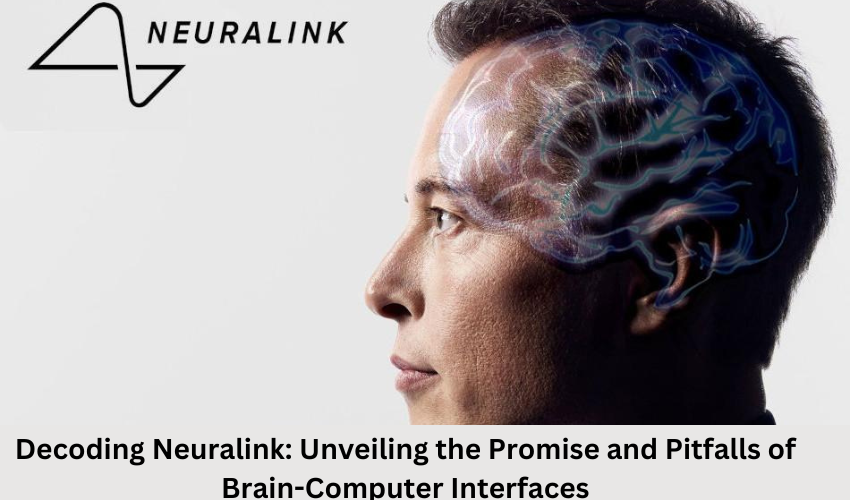Have you ever thought of the advantages of neurotech in recent research? There is no better example than Neuralink, a brainchild of Elon Musk, that is currently at the center of people’s attention & that is simultaneously evoking debates on every part of the globe. Neuralink is innovating on the boundary of brain-computer interface technology aiming to create an interactive world for people & ones who would be no more the same.
With their implantable devices & ambitious goal, the Neuralink, capable of re-nomination of lost functionality, betterment in cognitive works & direct one with the use of brain-to-brain communication, promises to do so. While excitement is there, the questions related ethics, transparency, & safety are still bothering.
While the mass benefits of such devices are indisputable, a lot of concerns including privacy violation, misuse of the implants, & the long-term impact on the enhancement of brain implants remain unsolved issues that trigger a dilemma in balancing innovation & responsibility, the fine line in the path to the development of technology.
Neuralink: Merging Minds with Machines
Image credit – NPR
Human-centered devices are currently being developed by the startup company Neuralink, established by Elon Musk in 2016 & focused on the manufacture of implantable brain-computer interfaces. This is the main product in their product line, the N1. This is a disk-shaped micro device that is 1,5 an inch in size, & within its threads are covered in tiny electrodes. This means that in this system the electrodes record neuronal activity which is later transferred wirelessly to a smartphone app.
The Neuralink, however, has the prime objective of helping human beings to control the external devices, as well as computers or phones, by simple thought. A most notable milestone was reached in the beginning of 2024 when the implant was able to re-enable one paralyzed patient with the skill to play chess.
From the viewpoint, Neuralink does not stop with the present vision, its further futuristic imagines are where its technology could help in restoring loss of movement or sight, enhance memory, & facilitate direct brain-to-brain communication.
Nevertheless, since this is a pioneer young company in the field of IoT devices, the ethical considerations & safety aspects are the most relevant at the moment.
The thick issue of brain implants in the long run, which involves some kinds of confidentiality, automaticity & safety aspects, happens to be a subject to academic research & analysis.
Breakdown of Neuralink’s Technology:
Image credit – Gaming Deputy
- Implant: N1 implant, coin-sized device that includes thread-like strands with electrodes for recording neural signals.
- Functionality: The implant will give users complete control over their environment by wirelessly transmitting neural signals to actuate the devices they need like computers or smartphones just by thinking about them.
- Achievement: In the early weeks of 2024 a paralyzed patient was able to operate the implant, playing chess.
- Future Applications: As for possible applications of the technology, it varies from enabling the restoration of movement & vision to enhancing memory as well as thinking directly between the brains.
- Challenges: Although their technology offers a vision of hope, safeguarding the principles of privacy, autonomy, & safety still seems to be an ethical issue of discussion. The future of brain implants is predicated on an exhaustive study & due consideration of their long-term safety & efficacy.
The Good:
Pioneering Brain-Computer Interface: The central role of the Neuralink’s implantable BCI technology to neurotechnology cannot be overemphasized as it is a critically pivotal step in that discipline, beyond doubt. N1 implant, which is of a complicated design with accurate mechanisms, is a remarkable landmark towards the process of more convenient interaction between the human brain & electronic apparatuses. The fact that it can record the signals as well as interpret them with more precision is what opens ample opportunities for people with disabilities, and neurological impairments.
Potential to Help People: Neuralink’s technology possesses a fantastic potential to cause an instant increase in the quality of life of a number of people living with inferior health states. Besides its rehabilitating capabilities, such as restoring lost functions of paralyzed people & enhancing the sensing perception, such as sight for the blind, it stands out to show its healing power. Multiple channels of data transmission from the brain to machines enable Neuralink to not only close the loop between mind & machine but to even empower individuals’ lives.
Future Applications: However, besides the direct uses of neurohacks, the research in this field moves the boundary in the human-machine connection further. Notions such as direct brain communication & the cognitive improvement show us a path of mental capacity exceeding which is quintessential to the future. Although these far-off possibilities may be seen as receding, they indicate Neuralink ‘s determination to radically reshape the essence of human consciousness & capability.
The Not So Good:
Ethical Concerns: While brain implants may offer great potential, their increasing usage also involves a number of intricate moral concerns, which should be thoroughly discussed. Issues of who owns the privacy of such data, the probability of its misuse & abuse & the psychological implications of its application are what later on require their regulation.
Animal Testing: Neuralink, as one of the most controversial firms, is heavily for the criticism of animal usage for experimental testing. Despite the fact that the company is following the regulations, however, the perception of inhumane treatment of the animals & their sheer necessity in advancing technology come at the same time. Maintaining this ideal of positive scientific advancement yet at the same time making ethical responsibility the key factor, these companies, & the neurotechnology community as a whole, are still facing a challenge.
Safety & Long-Term Effects: While the short-term effects of brain implants are surely positive, the long-term effects are a little bit mysterious, & that can only concern us with all the risks & negative results. Making safety of users a top priority & addressing various potential hazards should be done consistently by imposing a series of safety procedures & monitoring. Along the way to improvement of Neuralink products, the aspect of safety for the user still holds the key position.
The Uncertain:
Overblown Hype: Elon Musk’s Neuralink means much to the SpaceX founder’s name for pretty many people. The project attracted popular imagination to a great extent & its prospects have become the subject of many discussions recently. In addition, the critics call for reasonable expectations & stress that the tangible outcomes are more substantial than the talk alone & the technical issues are given the proper attention. Sustaining expectations compatibility & building a balance between the polyphony of ambitions & realism is going to be the main driver for Neuralink reputation & the possibility of a successful future.
Technical Hurdles: However, if Neuralink is to achieve public recognition, it will face critical technology problems on the way to creating the product widely used. Challenges like miniaturization, data transmission speed, & easy integration with the brain certainly are hard to overcome. These technical issues will certainly have to be faced with long-lasting innovations, collaboration, & research funding.
Neuralink Project Current Status
Image credit – The New York Post
Neuralink’s recent progress in the field of neural interfacing has stirred up a heated debate of support & fear among many factions. Even though thorough information on the results is usually not disclosed, bits of the information on the successes & failures found their way to the press, thus giving us a chance of getting more background on the project. Here’s an extended breakdown of what we know & what to anticipate in the future:
First Human Trial:
- May of 2023 was by all means the most crucial moment Neuralink has both received approval from The Food & Drug Administration for the maiden clinical trial on humans. This joining green light demonstrated that their technology is something worth testing on human subjects.
- On the other hand, the general vague details of the clinical trial, such as the nature of participants, the sample size, & the specific objectives, raised the curiosity for those who observe from the outside.
Promising Initial Signs:
- Neuron spike detection announcement during human trial by Elon Musk indicates that Neuralink has made significant progress & is steering the way towards deciphering & utilization of brain activity.
- The positive result of this test shows that the implant is a good way for this neural signal capturing. This gives good reason to keep hoping for more development of this brain-computer interface technology.
Chess-Playing Patient:
Image credit – The Guardian
- News items published by the media in January 2024 of a victim suffering from paralysis playing chess using a microchip created by Neuralink generated deep interest & joy.
- Although it provides an insight into how the technology could allow persons to interact with external devices using only their minds, doubts have been raised about the accuracy & broad application of such tools.
Limited Transparency:
- Decision of Neuralink to man around the rule of registering the trial with ClinicalTrials.gov has similarity to controversies within the scientific community which is not an irrelevant aspect of the story.
- Lack of leading indicators weakens data transparency, which in turn makes it difficult to trace responsibilities, repeatability, & independent confirmation, preventing achieving credibility & safety goals.
What to Watch For In The Future:
- Participant Numbers & Health Outcomes: Insights about participants’ number & type in the trial, besides health outcomes & side effects that emerged within the trial period is highly valued in the safety & effectiveness of the implant.
- Implant Functionality: Apart from the basics, such as chess game-playing, which is a starting point for the interface adaptability & sophistication in conveying & emulating the concepts & schemes within the neural comm& will be the real determining factor as to what all the interface can accomplish.
- Safety Measures: The ethical protocols & clinical trial safeguards employed throughout the trial need to be publicly declared. Assessing the implications & the participants’ well-being would go hand in hand.
Even though Neuralink’s recent progress brings us visions of humans easily interfacing with technology for unlimited possibilities, many risks & issues still lie in front of us. As Neuralink moves forth, this mission will require continuous vigilance, transparency, & collaboration while these pioneers of neuroscientific innovation aspire to finally convert the dreams of so many to reality.
Frequently Asked Questions
Here are some frequently asked questions:
1. What did Neuralink succeed in in May 2023?
- Neuralink obtained a green light from the FDA to commence Phase 1 clinical trials of their implantable brain-computer interface device in, allowing the firm to move forward with human testing.
2. What did Elon Musk tell about the encouraging sign during the human trial?
- From initial data assessment, Elon Musk stated that the implant was indeed capturing brain neuronal activity as reflected by the spiking neurons.
3. In what particular occurrence in the month of January 2024 Elon Musk’s Neuralink was used?
- In January 2024, a paralyzed patient successfully played chess using a Neuralink implant to control external devices, becoming his unique way of communication. This experience demonstrated why the technology is a one of a kind option to control external devices through thoughts.
4. Why did some scientists raise anxiety about Neuralink’s limited human trials transparency?
- There are scientists who have pointed out the company’s negligence in terms of being transparent, where they try to keep things hidden such as not registering their trial on ClinicalTrials.gov, a widely used platform known for openness in clinical research.
5. What are the main things to look for as Neuralink’s human trial goes on?
- As NEI’s trial progresses, pertinent metrics herein are the trial participant quantities & health outcomes, the functionality of the implant beyond basic tasks, & the safety considerations during the trial process.
Conclusion
With Neuralink playing a significant role in moving neuroscience forward, the impression is that we are at a crossroads, where human-machine association is becoming a mainstream topic. The idea that mobility to paralyzed individuals can be restored, cognitive abilities can be taken to the highest level, & telepathic communication can be enabled is clearly pureed at the moment to the soothing.
Ultimately, Neuralink & the idea of brain-computer interfaces are destined for as much success as its technological advancements & as much failure as human beings’ inability to tackle the ethical & social implications of combining human brains with machines. As we travel forth in the wide horizon, keeping our eyes & ears open, brains smart & working, & of course – to use technology to positively enhance humanity.








